By Molly Kirk/DWR
Photos by Meghan Marchetti/DWR
Not many people had heard of the subject of this year’s Virginia Department of Wildlife Recourses’ (DWR) Restore the Wild Artwork Competition—the eastern spotted skunk. The much more common striped skunk may come to mind first, but the spotted skunk has been identified as a Tier 4 (moderate conservation needed) Species of Greatest Conservation Need in the Virginia Wildlife Action Plan and the Restore the Wild committee asked artists to feature the spotted skunk’s preferred young forest habitat.
Artists submitted 73 creative entries for the competition, and a judging panel chose winners in the Natural History Illustration, Artistic Expression, and two age groups of Youth categories as well as artwork to be used throughout 2024 to help promote Restore the Wild. Each year, the contest calls for submissions from the public that reflect Restore the Wild’s mission to restore and create natural habitats vital to the survival of Virginia’s wildlife. The winners were announced at the opening night reception of the Restore the Wild Artwork Exhibit at Pine Camp Cultural Arts and Community Center in Richmond on March 8.
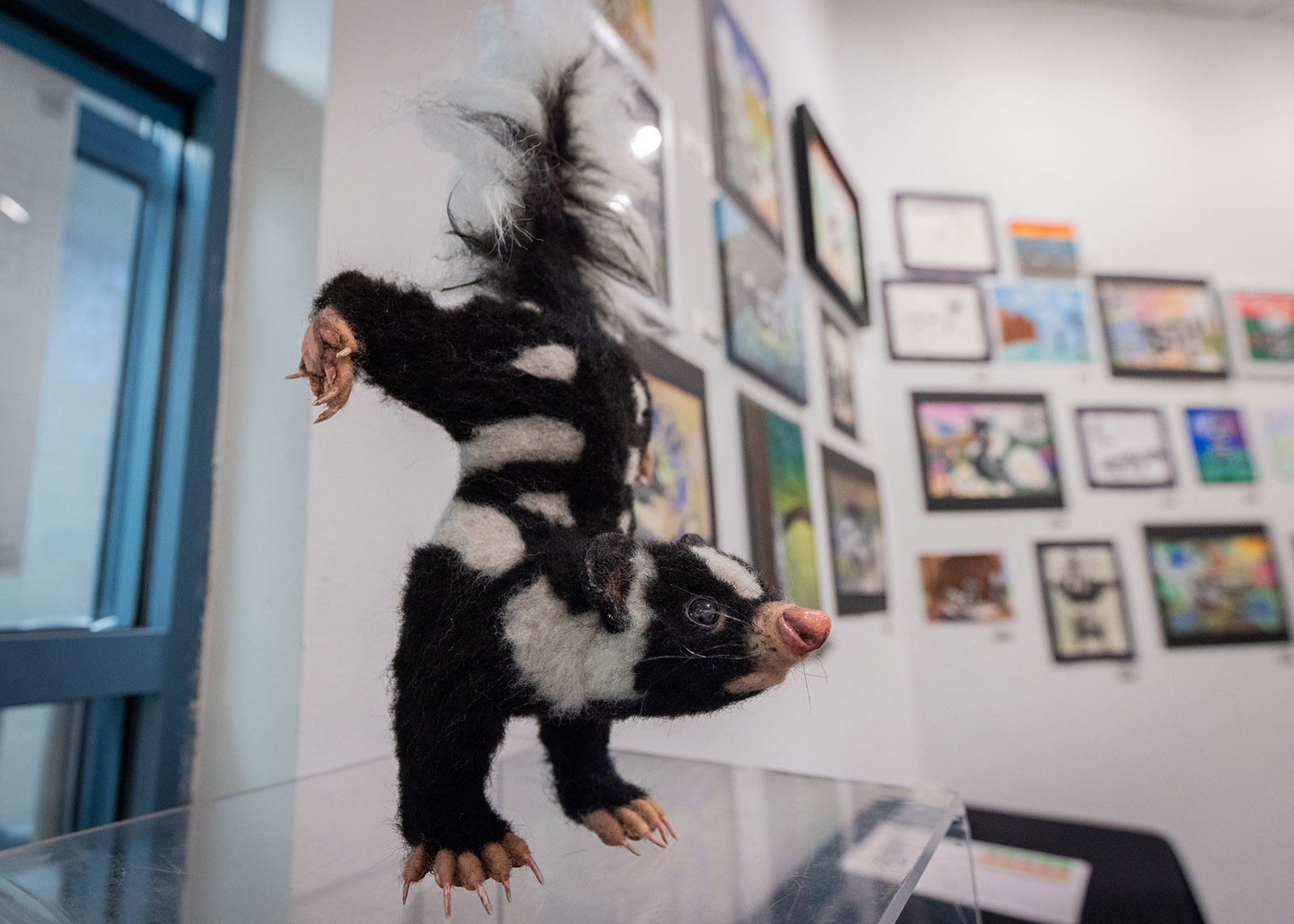
This remarkable felted spotted skunk created by Ebb & Felt wasn’t eligible for the Restore the Wild Artwork Competition, but is on display at the exhibit at Pine Camp Cultural Arts and Community Center.
“We’re thrilled that the enthusiasm of last year’s Restore the Wild Artwork Competition carried into this year and that we had so many fantastic entries,” said Stephen Living, Restore the Wild committee member and DWR habitat education coordinator. “The judges had a hard time picking winners, as all the work was of such a high quality. We also appreciate the partnership with the Pine Camp Cultural Arts and Community Center, which hosted the opening night reception for the exhibit.” All the contest entries are on display and available for the public to view at Pine Camp Cultural Arts and Community Center in Richmond on weekdays from 9 a.m. – 5 p.m. through Friday, March 29.
Ginko Bergel’s pencil depiction of eastern spotted skunks topped the Natural History Illustration category, which asked artists to create realistic scenes depicting the species in its natural habitat. “It’s such an honor! I’m a young professional in my field of illustration, so finding opportunities for work and competition are very difficult, but important to me,” said Bergel, of Lovettsville, Virginia. “I have a love for all things nature and outdoors and a particular fondness for the family mustelidae. [I am] doing my part, however small, to clean up in my local area and create artworks that celebrate and educate the public about our world. I am working on getting my Master Naturalist’s certification and hope to use that knowledge to further educate and inspire.”
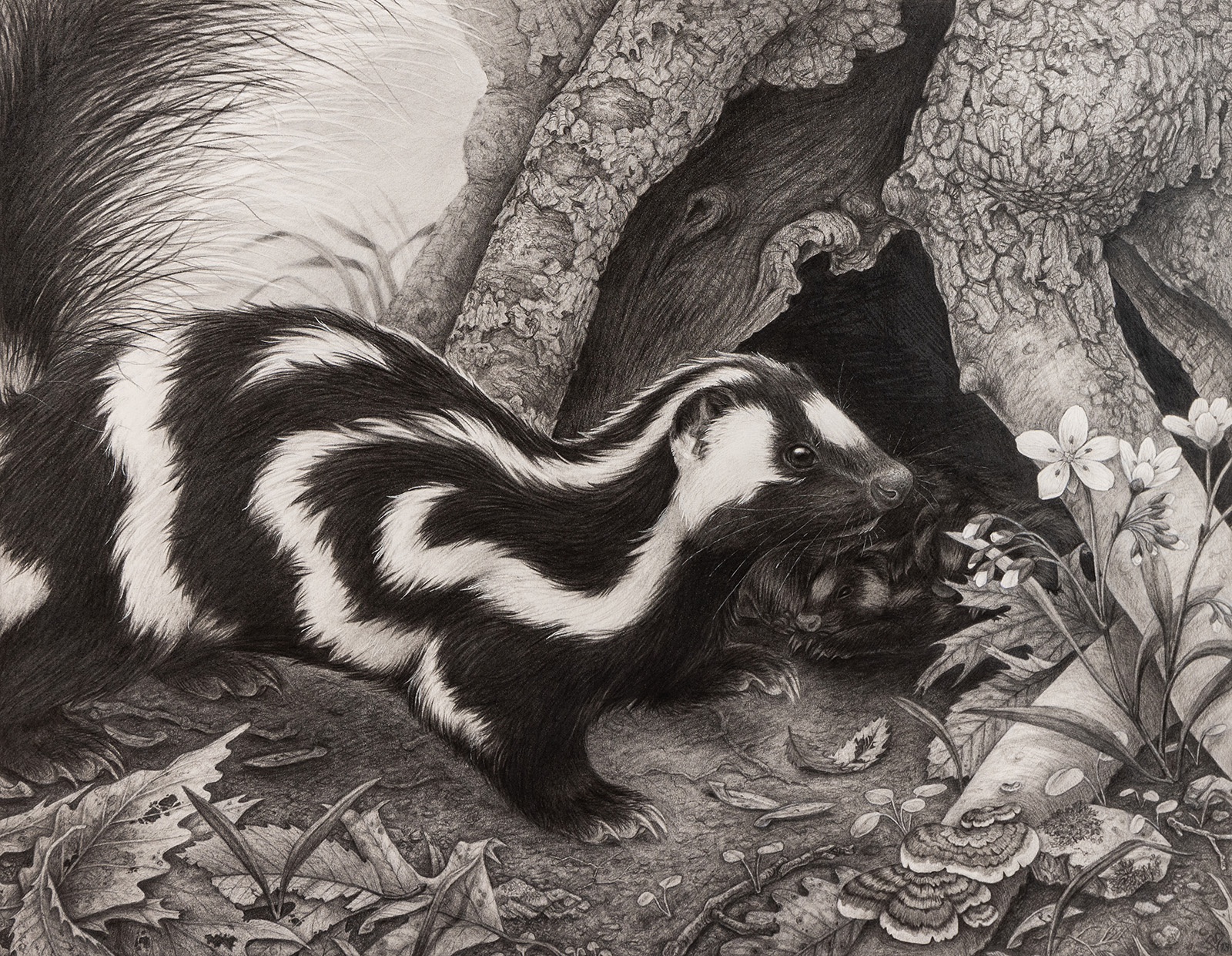
Ginko Bergel’s Eastern Spotted Skunk – winner Natural History Illustration.
The Artistic Expression category asked artists for their creative interpretation of the eastern spotted skunk and their habitat. Cassandra Kim earned the win in this category with her work, “Little Miss Eastern Spotted Skunk with Trout Lilies.” “I love painting animals, and I have a style that bridges the traditional with the surreal,” said Kim, of Richmond, Virginia. “Knowing that my artistic voice is welcome in being a part of bringing attention to a species in decline, and to win an award on top of that is so affirming.”
Kim has collaborated with the Virginia Department of Conservation and Recreation with art that highlighted local, at-risk animals and plants through surrealistic portraits. “In working on that show, I became more passionate on trying to bring attention to our local biodiversity,” she said. “When I found out about this competition, I thought it would a fun opportunity to be a part of bringing awareness to another animal in need.”

Cassandra Kim’s “Little Miss Eastern Spotted Skunk with Trout Lilies” – winner Artistic Expression
Given the number of youth entries in 2023, this year the Youth category was divided into ages 10 and under and 11-16. Savannah Brooks, of Boones Mill, Virginia, won the Youth, 11-16 category with her “The Scent of Summer” painting. “I hope that this painting of the eastern spotted skunk will bring as much joy to others as it has brought to me,” said Brooks. “I was inspired by a chance to create a piece that both displayed the eastern spotted skunk as well as showed its beautiful habitat. Additionally, I drew inspiration from some of my favorite places on our farm along the creek.”

Savannah Brooks’ “The Scent of Summer” – winner Youth, 11-16
Cydney Ji of Chantilly, Virginia, took top prize in the Youth, 10 and under category. “I was jumping with joy when I heard I won the Restore the Wild Artwork Competition,” said Ji. “My eighth birthday is coming up, so it is the most awesome birthday surprise ever. It makes me want to create even more amazing nature-inspired art in the future. The skunk doing a handstand is so unique and fun! I imagined he was trying to defend himself while doing it. I added a colorful background with flowers to show he’s living in a beautiful natural place.”
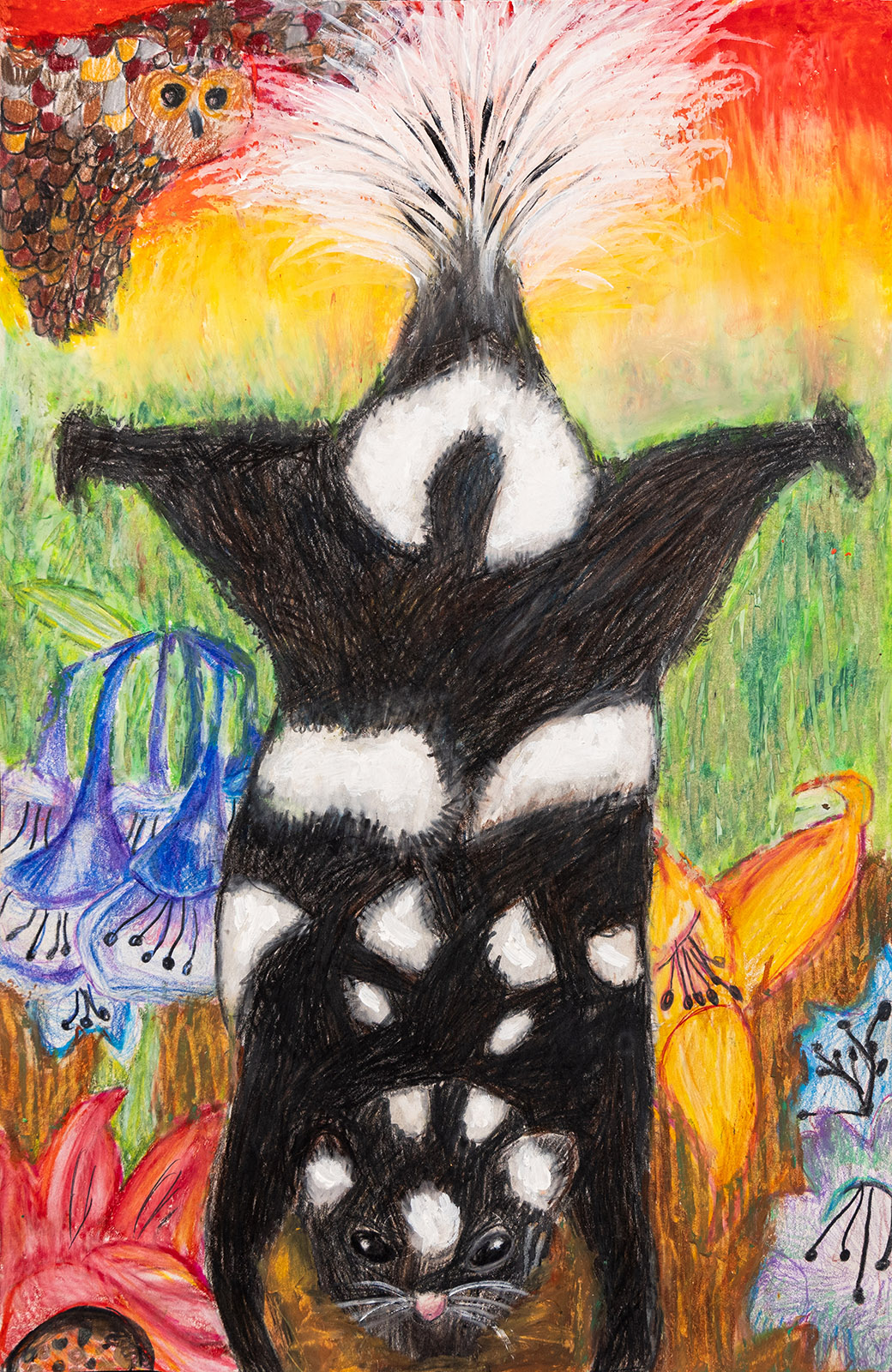
Cydney Ji’s “Eastern Spotted Skunk” – winner Youth, 10 & under
The judges chose Tam Norman’s linoleum print “Say Hello to my Little Friend!” to be reproduced in a commemorative Restore the Wild sticker given to all Restore the Wild members. “A close friend sent me the call to artists when first released, and I thought a skunk, especially a spotted skunk, would look really cool as a linoleum print,” said Norman, who lives in Aylett, Virginia. Through creating a work for the contest, Norman learned that “there was even such a thing as a spotted skunk,” she said. “I fully assumed that skunks were just that classic stripe pattern or similar. Also, that cool thing they do by posing with their backside in the air when they feel in danger? Wow! Something to note, if ever in western Virginia.”
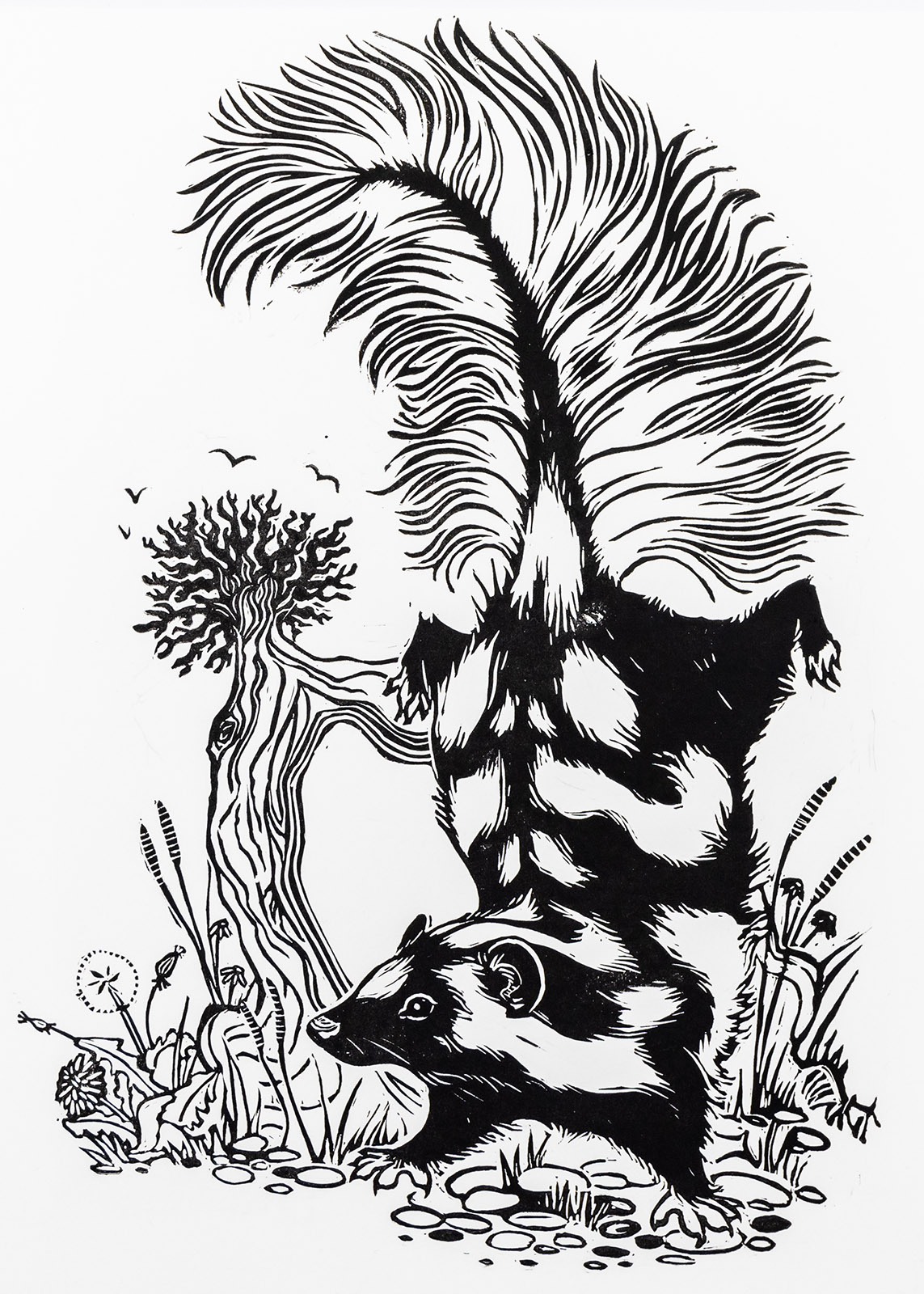
Tam Norman’s “Say Hello to my Little Friend” – winner Sticker
Shelley Whittington, of Ashland, Virginia, created “I’ve Spotted a Skunk!” the piece the judges picked to be reproduced as a print representing Restore the Wild’s focus species of 2024. This print will be given as a gift to Restore the Wild’s Golden Eagle members, the highest tier of membership. “Winning this award is so exciting and in line with my ongoing goal to promote habitat protection for all our native creatures right in our own backyards,” said Whittington, who has turned her 20-acre property into a Certified Wildlife Habitat.
“Living along the 95 corridor in Virginia, where the collection of tax revenue far exceeds the need of preservation of habitat for our wildlife, I believe I should do whatever I can to bring awareness to the amazing variety of wildlife that this beautiful state is home to, and to continue to educate the public to the importance of preservation, and habitat protection,” said Whittington.
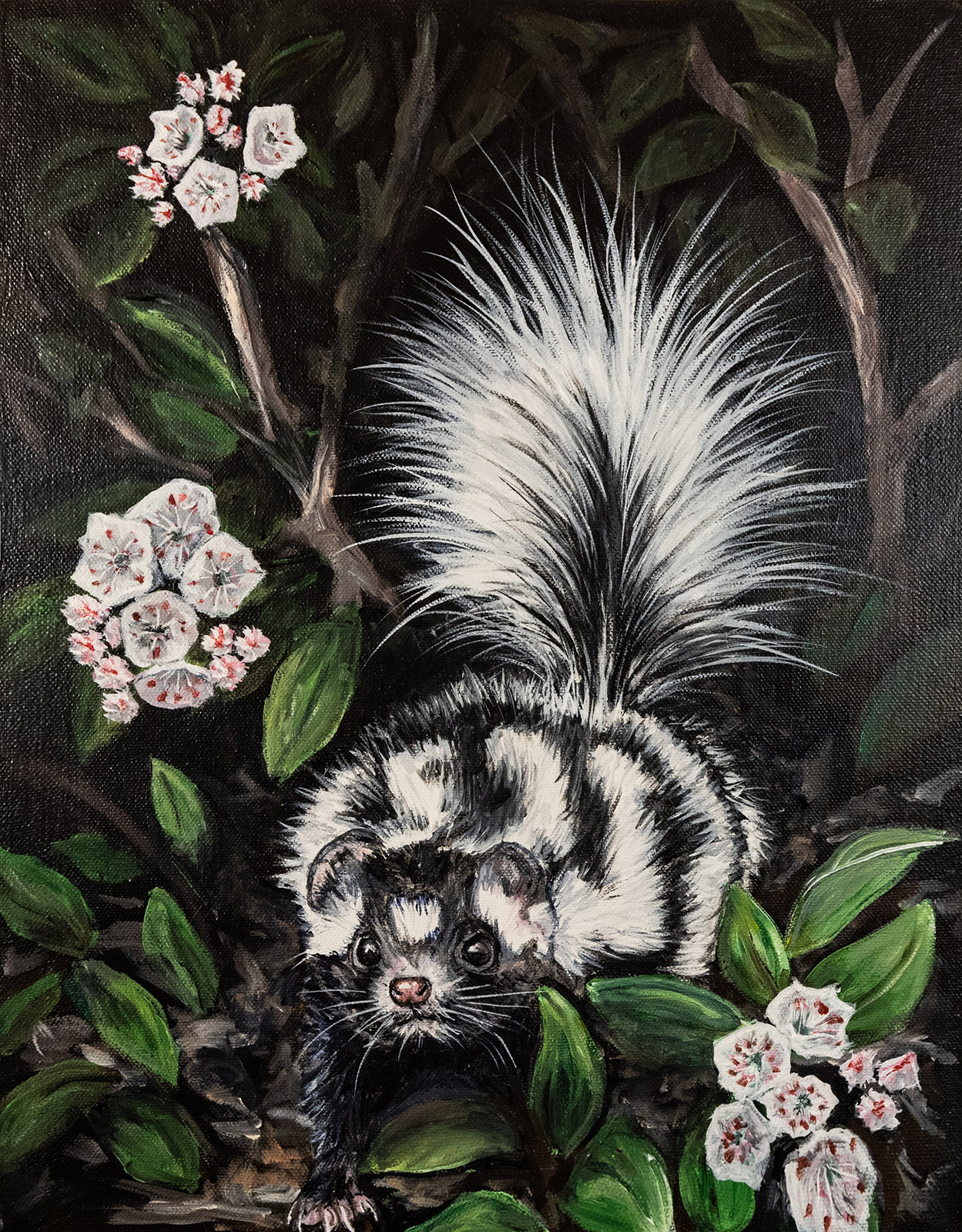
Shelley Whittington’s “I’ve Spotted a Skunk!” – winner Art Print
The subject focus of 2024’s artwork was the eastern spotted skunk. Not to be confused with the common striped skunk ubiquitous to back yards throughout the state, the spotted skunk has been identified as a Tier 4 (moderate conservation needed) Species of Greatest Conservation Need in the Virginia Wildlife Action Plan and is found in the foothills of the Blue Ridge Mountains and further west. This species is known for its unique handstand warning posture before it sprays. Before the 1940s, the eastern spotted skunk was abundant across its range, but in the last 80 years its populations have plummeted. The drivers of this collapse are not well understood, and most of them have not been studied systematically. Habitat loss, poisoning from insecticides, and competition with other small carnivores (such as raccoon, bobcat, and coyote) may all play a role.
Virginia has more than 900 species of wildlife whose numbers are in decline mostly because of impacts to their habitat—natural areas that provide necessary food, water, and shelter. DWR is the lead agency in Virginia for the conservation of wildlife and wildlife habitat. DWR’s Restore the Wild initiative allows DWR to expand the work the agency does to preserve, establish, and maintain vital wildlife habitat areas and keep Virginia’s wild places wild. Memberships and donations to Restore the Wild provide funds directly for DWR habitat projects that benefit Virginia Species of Greatest Conservation Need.
The first four years of Restore the Wild raised more than $150,000 in membership funds and donations. The funds were used immediately to support DWR habitat projects throughout the state, directly benefiting a diversity of imperiled wildlife. The initiative has funded more than 250 acres of habitat restoration in Virginia. The winning Artwork Competition pieces will be used to help promote Restore the Wild’s mission throughout 2024.
Find out more about DWR’s Restore the Wild initiative and consider becoming a member or making a donation to help restore and maintain essential habitat for Virginia’s wildlife. You can still visit the Restore the Wild Artwork Competition exhibition at the Pine Camp Cultural Arts and Community Center, 4901 Old Brook Road, Richmond, VA 23227—open to the public Monday – Friday, 9 a.m. – 5 p.m. through March 29.



